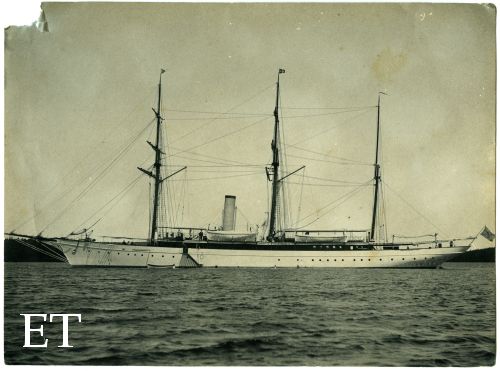Titanic's Big Game Hunter
/Thomas Drake emigrated from England to Pennsylvania in 1829, opened a fabric mill, and began manufacturing denim. Soon, he was making jeans under the trademark, ‘Kentucky Blue Jeans.’ He became the cloth supplier for the Union Army uniforms during the Civil War, and increased his wealth through various investments. When he died in 1890, his only surviving child, Charlotte, inherited his fortune, plus the family mansion, Montebello. Located in Germantown, Pennsylvania, it occupied a full square block.
et_6_montebello
Montebello, home of Charlotte Cardeza
At age 20, Charlotte had married James Cardeza, the grandson of a Portuguese Count, and had one son, Thomas. When Charlotte discovered that James had a mistress as well as another child, the marriage ended in divorce. As Thomas grew, the independently wealthy Charlotte traveled with him around the globe. She purchased a luxurious ocean-going yacht for their excursions, named the Eleanor. They traveled to the world’s most exotic ports with a crew of 39, and Charlotte soon preferred the Eleanor to Montebello, which she considered to be only her summer home.
et_7_eleanor
The Eleanor
A long-time associate of Charlotte wrote that she had a “wonderful mind, a splendid knowledge of literature, conversant with the best in music and art ... perhaps the most outstanding characteristic was her kindness, particularly to the poor and those in trouble.”
charlotte-cardeza
Charlotte Drake Cardeza
Charlotte and Thomas became big game hunters, bagging tigers, lions, and wild boar on African and Indian safaris. Charlotte became known as the best female hunter in America. In April 1912, they were returning to Pennsylvania following an African safari and a visit to Thomas’s hunting property in Hungary. Rather than take the Eleanor, mother and son booked passage on the Titanic, perhaps due to Thomas’s ill health.
cardeza_cw5
Charlotte on safari
They brought along 14 trunks, three large packing crates, four suitcases, Charlotte’s maid, and Thomas’s valet. They booked the most expensive suite of rooms on the ship, which included two bedrooms, a wardrobe room, a sitting room, a bath, and a 50-foot private promenade.
thomas-cardeza
Thomas Cardeza
As the lifeboats were loaded following the collision with the iceberg, Charlotte managed to convince the crew to allow Thomas to board Lifeboat 3 with her, along with their maid and valet. Also on Lifeboat 3 were the Speddens. Mrs. Spedden later recorded in her diary an account of that night, and historians believe the following passage refers to Charlotte Cardeza:
“One fatwoman in our boat had been a handful all along, for she never stopped talking and telling the sailors what to do… As we approached (the Carpathia) “our woman” promptly sprang up in order to get off first, when we had been warned to sit still, and it gave me the greatest satisfaction to grab her by her lifebelt and drag her down. She fell in the bottom of the boat with her heels in the air and was furious because we held her there till we were alongside the Carpathia when we were charmed to let her go up in the sling first.”
Charlotte later sued the White Star Line for the loss of her valuables. The amount of the claim, nearly 36,000 British pounds, or around $178,000, was the highest of any passenger. She finally settled down at Montebello when her health began to fail, and died in 1939. She was 85.
She left several priceless paintings to the Philadelphia Museum of Art, and a generous yearly stipend to her maid. Most of her estate was left to Thomas. The same year, Thomas and his wife, Mary, gave a $5,000,000 endowment to Thomas Jefferson University in Philadelphia to found the Charlotte Drake Cardeza Foundation. Mary suffered from a chronic blood disorder, and the specific purpose of the Foundation was to be for research in diseases of the blood. Its work continues today, with renowned research and educational programs.
Photo credits: aftitanic.free.fr, encyclopediatitanica.com





